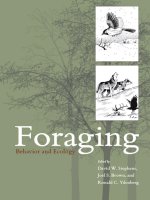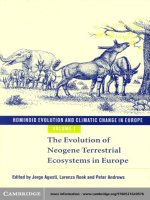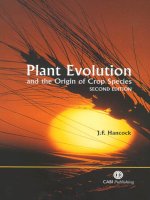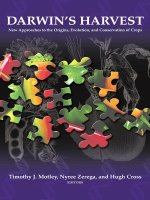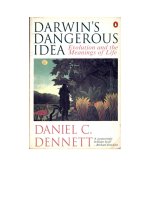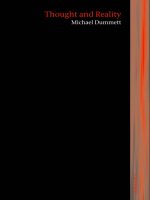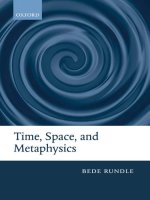- Trang chủ >>
- Khoa Học Tự Nhiên >>
- Vật lý
reticulate evolution and humans origins and ecology dec 2008
Bạn đang xem bản rút gọn của tài liệu. Xem và tải ngay bản đầy đủ của tài liệu tại đây (2.93 MB, 246 trang )
Reticulate Evolution and Humans
This page intentionally left blank
Reticulate Evolution
and Humans
Origins and Ecology
Michael L. Arnold
Department of Genetics, University of Georgia, Athens, Georgia, USA
1
3
Great Clarendon Street, Oxford OX2 6DP
Oxford University Press is a department of the University of Oxford.
It furthers the University’s objective of excellence in research, scholarship,
and education by publishing worldwide in
Oxford New York
Auckland Cape Town Dar es Salaam Hong Kong Karachi
Kuala Lumpur Madrid Melbourne Mexico City Nairobi
New Delhi Shanghai Taipei Toronto
With of ces in
Argentina Austria Brazil Chile Czech Republic France Greece
Guatemala Hungary Italy Japan Poland Portugal Singapore
South Korea Switzerland Thailand Turkey Ukraine Vietnam
Oxford is a registered trade mark of Oxford University Press
in the UK and in certain other countries
Published in the United States
by Oxford University Press Inc., New York
© Michael L. Arnold 2008
The moral rights of the author have been asserted
Database right Oxford University Press (maker)
First published 2008
All rights reserved. No part of this publication may be reproduced,
stored in a retrieval system, or transmitted, in any form or by any means,
without the prior permission in writing of Oxford University Press,
or as expressly permitted by law, or under terms agreed with the appropriate
reprographics rights organization. Enquiries concerning reproduction
outside the scope of the above should be sent to the Rights Department,
Oxford University Press, at the address above
You must not circulate this book in any other binding or cover
and you must impose the same condition on any acquirer
British Library Cataloguing in Publication Data
Data available
Library of Congress Cataloging in Publication Data
Data available
Typeset by Newgen Imaging Systems (P) Ltd., Chennai, India
Printed in Great Britain
on acid-free paper by
Antony Rowe
ISBN 978–0–19–953958–1 (Hbk.)
10 9 8 7 6 5 4 3 2 1
Picasso liked to add, combine, and stick things together just as much as he liked to strip,
undo, prune, and purify: “The supreme art is to summarize,” André Masson would write,
referring to the long evolution of image into symbol from naturalism . . . and then into quasi-
abstraction . . . whose graphic quality adopts the simple rhythm of a prehistoric figure.
(Léal, Piot, and Bernadac, The Ultimate Picasso, 2003, p. 360)
To Frances, Brian, and Jenny. You make my life rich.
vii
ways in which the findings presented might be
applied.
To paraphrase one of my Mom’s favorite max-
ims, I believe that any author worth the powder it
would take to blow him or her up recognizes the
collaborative nature of book writing. In that con-
text, this book reflects ideas and topics concern-
ing which a set of colleagues and I have argued
and published over the past two decades or so.
In particular, Axel Meyer and I wrote a review
of data indicating the widespread occurrence of
reticulate evolution among primates, including
H. sapiens. This, along with a 2004 review for the
journal Molecular Ecology—where I was allowed to
explore the effect of genetic exchange on the evo-
lution of organisms with which humans interact—
provided a solid conceptual basis for this book.
I also wish to thank Professors Peter Holland
and Paul Harvey of the Department of Zoology
and Professor Dame Jessica Rawson of Merton
College for providing a Research Fellowship at
Oxford University during which time I began
the writing of this book. Similarly, I must thank
Professor Wyatt Anderson of the University of
Georgia who facilitated my work at Oxford by
assuming some of my duties in the Department
of Genetics. I have much gratitude also for Eleanor
Kuntz, Jacob Moorad, Rebecca Okashah, Eileen
Roy, and Natasha Sherman for reading and cri-
tiquing earlier drafts of the chapters. Theirs was
definitely a labor of kindness toward the author.
Ian Sherman, my editor and friend, has provided
continual support during this project. I want to
thank him for cheerfully answering the same
questions more than once. Ian’s assistant, Helen
Eaton, also gave great guidance as this project
developed. During the period of writing, I was
This book is an exploration of how the transfer
of genes between divergent lineages—through a
diverse array of mechanisms—has affected, and
continues to affect, humans. In particular, it is a
journey into the data that support the hypothesis
that Homo sapiens as well as those organisms on
which it depends for survival and battles against
for existence are marked by mosaic genomes.
This mosaicism reflects the rampant (as reflected
by the proportion of organisms that illustrate this
process) exchange of genetic material during evo-
lutionary diversification. This is the underlying
hypothesis for this book. I hope to show in the
following chapters that it also reflects the consist-
ent observation made when the genomes of organ-
isms are mined for genetic variation.
Chapter 1 provides a basis for much of the ter-
minology used throughout. It also illustrates many
of the concepts, processes, and mechanisms that
characterize reticulate evolution. In Chapters 2–4,
I will illustrate how genetic exchange has impacted
greatly the genetic variation and evolutionary
trajectories of primates in general, and the clade
containing our own genus and those genera with
which we share the closest ancestry in particular.
Chapters 5–7 contain a description of the reticu-
late evolutionary history of organisms that benefit
worldwide populations of H. sapiens through the
provision of shelter, clothing, and sustenance. In
Chapter 8, I turn to the question of how genetic
exchange may have led to the origin and evolution
of those viruses, bacteria, and so on, which breach
physical and physiological defenses to cause epi-
demics and pandemics among humans. Finally, in
Chapter 9, I will briefly direct the reader to con-
sider the evidence presented in the previous chap-
ters to draw general conclusions and to suggest
Preface
viii PREFACE
gravity and oxygen. I can think of no better expres-
sion of my undying gratitude for the person who
knows me the best, and loves me anyway. Thank
you Frances. Like the two previous books, I dedi-
cate this to you and our children, Brian and Jenny.
supported financially by the National Science
Foundation grant, DEB-0345123.
One of my favorite authors, John Piper, wrote
in the preface to his book Desiring God (2003;
Multnomah Books) that he relied on his wife like
ix
Preface vii
1 Reticulate evolution: an introduction 1
1.1 Reticulate evolution and the development of the web-of-life metaphor 1
1.2 Examples of evolutionary consequences from introgressive hybridization:
animals 5
1.2.1 Evolution of adaptations and hybrid speciation: Darwin’s nches 5
1.2.2 Evolution of adaptations and hybrid speciation: African cichlids 10
1.3 Examples of evolutionary consequences from introgressive
hybridization: plants 13
1.3.1 Evolution of adaptations and hybrid speciation: Louisiana Irises 13
1.3.2 Introgression and hybrid speciation:
Arabidopsis
16
1.4 Examples of the evolutionary consequences from horizontal gene
transfer: prokaryotes 18
1.4.1 Transfer of adaptive machinery: bacteria and archaebacteria 18
1.4.2 Horizontal transfer and species distributions: thermophylic
bacteria 19
1.5 Summary and conclusions 20
2 Reticulate evolution: nonhominine primates 21
2.1 Reticulate evolution in New World nonhominines 21
2.1.1 Introgressive hybridization: howler monkeys 22
2.1.2 Introgressive hybridization: spider monkeys 24
2.1.3 Introgressive hybridization: marmosets and tamarins 26
2.2 Reticulate evolution in Old World nonhominines 26
2.2.1 Introgressive hybridization in Lemuriformes 27
2.2.2 Introgressive hybridization in slow lorises 29
2.2.3 Introgressive hybridization in langurs and leaf monkeys 29
2.2.4 Introgressive hybridization and hybrid speciation in
cercopithecines 30
2.2.5 Introgressive hybridization in the Hominidae and Hylobatidae 40
2.3 Summary and conclusions 42
3 Reticulate evolution in the hominines 44
3.1 Reticulate evolution within and among
Pan
,
Gorilla
, and
Homo
and
their ancestors 44
3.2 Reticulate evolution in the hominine fossil record: analogies and
Australopithecus
45
Contents
x CONTENTS
3.3 Reticulate evolution in the hominines: molecular evidence of
introgressive hybridization and hybrid lineage formation 46
3.3.1 Evidence of
Homo
×
Gorilla
×
Pan
introgression and
the origin of hybrid taxa 47
3.3.2 Evidence of introgression within
Gorilla
and
Pan
53
3.4 Summary and conclusions 64
4 Reticulate evolution in the genus
Homo
65
4.1 Reticulate evolution within
Homo
65
4.2 Models of
Homo
evolution: Replacement, Multiregional, and
Hybridization 66
4.3 Tests of the Multiregional, Replacement, and Hybridization/
Introgression Models of human evolution 66
4.3.1 Testing the models of human evolution: fossil evidence of
the co-occurrence of species 68
4.3.2 Testing the models of human evolution: evidence of hybrid fossils 70
4.3.3 Testing the models of human evolution: molecular evidence 72
4.3.4 Testing the models of human evolution: additional evidence 79
4.4 Summary and conclusions 80
5 Reticulate evolution and benefi cial organisms—part I 81
5.1 Reticulate evolution and the formation of organisms utilized by humans 81
5.2 Reticulate evolution and human companions 83
5.2.1 Reticulate evolution and canids 83
5.2.2 Reticulate evolution and the domestic cat/wildcat assemblage 88
5.2.3 Reticulate evolution and genets 90
5.3 Reticulate evolution and human burden bearers 91
5.3.1 Reticulate evolution and the donkey 91
5.3.2 Reticulate evolution and the water buffalo 92
5.4 Reticulate evolution and human clothing 93
5.4.1 Reticulate evolution and cotton 93
5.4.2 Reticulate evolution and deerskins 94
5.4.3 Reticulate evolution and caribou/reindeer skins 95
5.5 Reticulate evolution of fuel, building materials, corks, and containers 96
5.5.1 Reticulate evolution of wood products—fuel 96
5.5.2 Reticulate evolution of wood products—building materials 97
5.5.3 Reticulate evolution of wood products—cork 98
5.5.4 Reticulate evolution of containers—bottle gourds 99
5.6 Reticulate evolution of drugs 100
5.6.1 Reticulate evolution and atropine 100
5.6.2 Reticulate evolution and essential oils 101
5.6.3 Reticulate evolution and chocolate 102
5.6.4 Reticulate evolution and tobacco 103
5.6.5 Reticulate evolution and alcohol 104
5.6.6 Reticulate evolution and coffee 105
5.6.7 Reticulate evolution and
Cannabis
106
5.7 Summary and conclusions 107
CONTENTS xi
6 Reticulate evolution and benefi cial organisms—part II 109
6.1 Reticulate evolution and the formation of organisms utilized
by humans 109
6.2 Reticulate evolution and sources of animal protein 111
6.2.1 Reticulate evolution and shell sh 111
6.2.2 Reticulate evolution and sh: trout 114
6.2.3 Reticulate evolution and sh: peacock bass 115
6.2.4 Reticulate evolution and sh: cod 116
6.2.5 Reticulate evolution and sh: eels 117
6.2.6 Reticulate evolution and sh: Dolly Varden 118
6.2.7 Reticulate evolution and sh: tuna 119
6.2.8 Reticulate evolution and birds: ducks 120
6.2.9 Reticulate evolution and birds: partridge 122
6.2.10 Reticulate evolution and mammals: sheep 122
6.2.11 Reticulate evolution and mammals: goats 123
6.2.12 Reticulate evolution and mammals: chamois 126
6.2.13 Reticulate evolution and mammals: banteng/kouprey 127
6.2.14 Reticulate evolution and mammals: cattle 128
6.2.15 Reticulate evolution and mammals: kob and waterbuck 128
6.2.16 Reticulate evolution and mammals: oryx and sable antelope 130
6.2.17 Reticulate evolution and mammals: elephants and wooly
mammoths 130
6.2.18 Reticulate evolution and mammals: pigs 132
6.2.19 Reticulate evolution and mammals: hares and rabbits 132
6.3 Summary and conclusions 134
7 Reticulate evolution and benefi cial organisms—part III 135
7.1 Reticulate evolution and the formation of organisms utilized
by humans 135
7.2 Reticulate evolution and plant-based food sources 136
7.2.1 Reticulate evolution and honey 136
7.2.2 Reticulate evolution and root crops: potato 137
7.2.3 Reticulate evolution and root crops: cassava 139
7.2.4 Reticulate evolution and root crops: yams 140
7.2.5 Reticulate evolution and seed crops: pearl millet 142
7.2.6 Reticulate evolution and seed crops: wheat 143
7.2.7 Reticulate evolution and seed crops: Eragrostis 143
7.2.8 Reticulate evolution and seed crops: peanut 144
7.2.9 Reticulate evolution and seed crops: rice 145
7.2.10 Reticulate evolution and seed crops: maize 146
7.2.11 Reticulate evolution and seed crops: pea 147
7.2.12 Reticulate evolution and seed crops: cowpea 148
7.2.13 Reticulate evolution and seed crops: common bean 149
7.2.14 Reticulate evolution and fruit crops: breadfruit 149
7.2.15 Reticulate evolution and fruit crops: peach palm 151
7.2.16 Reticulate evolution and fruit crops: apples 151
xii CONTENTS
7.2.17 Reticulate evolution and fruit crops: coconut 153
7.2.18 Reticulate evolution and fruit crops: pepino 154
7.2.19 Reticulate evolution and fruit crops: citrus 155
7.2.20 Reticulate evolution and sugarcane 156
7.3 Summary and conclusions 157
8 Reticulate evolution of disease vectors and diseases 158
8.1 Reticulate evolution and the development of human disease vectors
and diseases 158
8.2 Reticulate evolution and human disease vectors 159
8.2.1 Reticulate evolution and Triatoma, the vector for Chagas disease 159
8.2.2 Reticulate evolution and
Simulium
, the vector for river blindness 161
8.2.3 Reticulate evolution and
Culex
species 162
8.2.4 Reticulate evolution and
Anopheles
species 162
8.3 Reticulate evolution and human diseases 164
8.3.1 Reticulate evolution and viral pathogens 165
8.3.2 Reticulate evolution and bacterial pathogens 169
8.3.3 Reticulate evolution and protozoan pathogens 175
8.3.4 Reticulate evolution and protist pathogens 178
8.3.5 Reticulate evolution and fungal pathogens 179
8.3.6 Reticulate evolution and parasitic roundworms 180
8.4 Summary and conclusions 181
9 Epilogue 182
9.1 Reticulate evolution and humans: what have we learned? 182
9.2 Reticulate evolution and humans: how do we apply what we
have learned 183
Glossary 185
References 187
Index 223
1
so on, and (4) the disease carrying and causing
vectors and pathogens with which we battle for
survival. Through the development of this frame-
work, I hope to illustrate the conclusion that the
tree-of-life metaphor is insufficient both in terms
of predicting and explaining evolutionary patterns
and process. As my colleagues and I have argued
earlier (Arnold and Larson 2004; Arnold 2006), evo-
lutionary diversification is best illustrated not as a
bifurcating, ever-diverging, tree-like structure, but
rather as a web made up of genetic interactions
between different strands (i.e., lineages).
1.1 Reticulate evolution and the
development of the web-of-life
metaphor
The goal of this book is to provide a framework
for understanding the evolutionary effects that are
generated by the exchange of genes between organ-
isms belonging to divergent lineages. In particular,
I will examine the contribution of reticulate evolu-
tion to the origin and development of (1) our own
species, (2) primates in general, (3) the organisms
on which humans depend for food, clothing, and
CHAPTER 1
Reticulate evolution: an
introduction
It is impossible to doubt that there are new species produced by hybrid generation.
(Linnaeus 1760)
. . . studies of some species complexes have indeed been couched in terms of a web-of-life,
rather than a tree-of-life metaphor . . . while others were designed with an appreciation of both
metaphors.
(Arnold 2006)
. . . there is growing evidence that lateral gene transfer has played an integral role in the evolu-
tion of bacterial genomes, and in the diversification and speciation of the enterics and other
bacteria.
(Ochman et al. 2000)
It is suggested that the chief effect of hybridization in this genus in eastern North America . . . is
to increase variability in the parental species.
(Anderson 1936)
The only data sets from which we might construct a universal hierarchy including prokaryotes,
the sequences of genes, often disagree and can seldom be proven to agree. Hierarchical structure
can always be imposed on or extracted from such data sets by algorithms designed to do so, but
at its base the universal TOL rests on an unproven assumption about pattern that, given what
we know about process, is unlikely to be broadly true.
(Doolittle and Bapteste 2007)
2 RETICULATE EVOLUTION AND HUMANS
species to exploit novel environmental settings
(Lawrence and Ochman 1998). Indeed, adaptive
trait transfer (Arnold 2006) forms part of the basis
for the ecological breadth of numerous prokaryo-
tes that cause devastating pathologies in human
populations (e.g., Faruque et al. 2007).
Given the recognition of (1) the great diversity
generated by the horizontal transfer of genetic
elements in prokaryotes (and indeed in viral line-
ages as well; e.g., Heeney et al. 2006) and (2) the
role of natural hybridization and introgressive
hybridization (i.e., “introgression”; Anderson
and Hubricht 1938) in the origin and evolution
of plant lineages (Anderson 1949; Anderson and
Stebbins 1954; Grant 1981; Arnold 1997, 2006), it
is surprising that the tree-of-life metaphor has
also been assumed the best descriptor by many
evolutionary botanists (Grant 1981). In fact, entire
clades are now known to rest on reticulate events.
For example, the formation of allopolyploid spe-
cies in flowering plants is one of the most impor-
tant evolutionary processes and is estimated to
underlie clades containing 50% or more of all
angiosperms (Stebbins 1947, 1950; Grant 1981;
Soltis and Soltis 1993; Masterson 1994). Similarly,
introgressive hybridization is now recognized as
one of the major outcomes from hybridization
between related plant taxa (Arnold 1997, 2006).
As mentioned above, genetic exchange events
between bacterial and viral lineages may lead to
the origin and/or transfer of adaptive traits. Such
is also the case for introgression between differ-
ent plant taxa (Anderson 1949; Arnold 1992; Heiser
1951; Kim and Rieseberg 1999, 2001; Martin et al.
2005, 2006; Whitney et al. 2006).
Introgression via sexual reproduction is not the
only avenue by which genetic exchange events take
place among plant lineages. Similar to prokaryo-
tes, plant clades reflect the signatures of lateral
transfer events as well. For example, the lateral
transfer of plant mitochondrial DNA (i.e., mtDNA)
appears frequent. One mechanism for mtDNA
transfers (similar to what has been demonstrated
for animal lineages: for example, see Houck et al.
1991; Kidwell 1993) has involved genetic exchange
between host plants and their parasitic plant
associates. Davis et al. (2005) detected an exam-
ple of this form of horizontal transfer involving
Studies in the field of evolutionary biology are
often characterized as being either pattern or
process focused. Those that examine the relation-
ships among evolutionary lineages are considered
pattern based while studies of the factors that
lead to evolutionary change are said to be proc-
ess oriented. Yet this dichotomy does not capture
the underlying complexity. For example, analy-
ses designed to provide phylogenetic resolution
almost always can be used to at least generate, if
not also test, hypotheses concerning the processes
that contributed to the resolved pattern. Similarly,
the resolution of processes—for instance, those
factors that lead to some measure of reproductive
isolation—are often used as data sets for deter-
mining evolutionary relatedness (i.e., pattern). In
this chapter, I emphasize the process side of this
dichotomy to provide the conceptual and termi-
nological basis for the subsequent discussions.
However, in the following chapters both process-
and pattern-based studies and findings will be
reviewed and discussed.
The restrictive nature of the pattern–process
characterization of evolutionary studies is illus-
trative of the similarly limiting metaphor known
as the “tree of life.” In this case, the proposal
that all life can be represented as a branching,
evolutionary “tree” (Darwin 1859) led under-
standably to the construction of algorithms that
allowed only the delimitation of dichotomously
diverging representations (e.g., Swofford 1998). It
is thus inevitable that with such a constraining
assumption—that is, evolution proceeds prima-
rily, or exclusively, by a process of divergence—
phylogenetic representations would of course
resolve into “trees.” However, over the last several
decades, some microbiologists interested in evolu-
tionary pattern have argued that the accuracy of
such representations, especially for prokaryotes,
should be reevaluated (e.g., Doolittle et al. 1996;
2003; Zhaxybayeva et al. 2004). The reevaluation
has resulted in the recognition of widespread
reticulate evolution in the prokaryotic clade
(Ochman et al. 2005). Furthermore, in terms of
process-oriented effects, the widespread exchange
of genes through lateral or horizontal transfer
has resulted in the transfer and de novo origin of
adaptations, allowing the recipient, prokaryotic
RETICULATE EVOLUTION: AN INTRODUCTION 3
with the largely parasitic angiosperm order that
includes sandalwoods and mistletoes. Davis et al.
(2005) concluded, “These discordant phylogenetic
placements suggest that part of the genome in
B. virginianum was acquired by horizontal gene
transfer” (see Box 1.1).
a parasitic flowering plant and a fern species.
In particular, phylogenetic analyses using three
mitochondrial gene regions positioned the rattle-
snake fern (Botrychium virginianum) with other
fern species. However, two other mtDNA gene ele-
ments indicated a closer evolutionary relationship
Phylogenetic discordance can be caused by the
exchange of genes by the differential transfer of
genetic elements between divergent evolutionary
lineages. Discordance would thus arise if genetic
loci that have been exchanged and those
that have not been exchanged were utilized
in constructing separate phylogenies. Panel 1
and 2 indicate the results of the phylogenies
derived from exchanged and nonexchanged
loci, respectively. Both are accurate refl ections
of evolutionary processes and the underlying
evolutionary relatedness of the loci and thus
the organisms under investigation. In one case
(Panel 1), the close evolutionary relationship
between different lineages has arisen more
recently through reticulation, while the
relationships defi ned in Panel 2 refl ect more
ancient associations. However, both refl ect
descent from a common ancestor for the
specifi c loci used in the analysis. The detection
of “phylogenetic discordance” (i.e., the
disagreement between the resolved phylogenies)
refl ects the transfer of Locus 1, but not Locus 2
and is thus a signature of reticulate evolution.
Box 1.1 Genetic Exchange and Discordant Phylogenies
No genetic exchange of locus 2
between A and C
Resulting phylogeny
ACDBDABC
Panel 2
Genetic exchange of locus 1
between A and C
Resulting phylogeny
AC
D
BD
ABC
Panel 1
4 RETICULATE EVOLUTION AND HUMANS
Arnold 1997, 2006). For example, in a recent analy-
sis of Z-chromosome loci from the hybridizing
swallowtail butterfly species, Papilio glaucus and
Papilio canadensis, Putnam et al. (2007) detected
extremely discordant estimates of time since
divergence. This led to the conclusion that the
DNA sequence variation of the Z-chromosomes
carried by these species had been structured by
long-term introgressive hybridization, but with
different regions of the chromosomes having been
exchanged at different frequencies. In particular,
Putnam et al. (2007) inferred that “the Z chro-
mosome is a mosaic of regions that differ in the
extent of historical gene flow, potentially due to
isolating barriers that prevent the introgression of
species-specific traits that result in hybrid incom-
patibilities.”
In the following chapters, I will discuss numer-
ous examples of the reticulate evolution of
microorganism, plant, and animal species that
have positive or deleterious effects on humans.
Furthermore, I will describe in detail the available
evidence indicating that Homo sapiens (and many
other extant and extinct primates) evolved in the
face of lateral transfers and introgressive hybridi-
zation. However, though the purpose of this book
is to illustrate why the “web-of-life” metaphor
The above, brief, summary indicates that
prokaryotic, viral, and plant evolution are often
better represented by the metaphor of a web of
life rather than a tree of life (Arnold 2006). Indeed,
reticulate evolutionary patterns and processes are
observed throughout these major clades. However,
animal taxa also bear the genetic footprints of the
processes of lateral transfer and introgression. For
example, Tarlinton et al. (2006) detected the recent
and ongoing invasion (i.e., lateral transfer) of the
koala genome by an exogenous retrovirus that is
transitioning into an endogenous viral element. In
particular, they noted that
The finding that some isolated koala popula-
tions have not yet incorporated KoRV into their
genomes, combined with its high level of activity
and variability in individual koalas, suggests that
KoRV is a virus in transition between an exog-
enous and endogenous element . . . and . . . provides
an attractive model for studying the evolutionary
event in which a retrovirus invades a mammalian
genome. (Tarlinton et al. 2006)
In addition to genetic exchange via lateral
transfer, animal clades are now understood to
reflect frequent gene transfers through introgres-
sive hybridization (Dowling and DeMarais 1993;
Figure 1.1 Schematic representation of the “web of life.” The bold lines interconnecting the various lineages indicate representative,
known lateral exchanges between different domains of life. The insets represent representative, known introgression events deriving from
sexual reproduction between divergent lineages. The dashed lines reflect a small number of the additional exchange events known to have
occurred. (References for the exchange events: “HIV,” see discussion in Chapter 8; “mitochondrial ribosome proteins,” see Bonen and Calixte
2006; “proteorhodopsin genes,” see Frigaard
et al.
2006; “transposable elements,” see Filée
et al.
2007; “red wolves, gray wolves, coyotes,
breadfruit, cherries, maize,” see discussion in Chapters 5–7.)
Archaebacteria
Proteorhodopsin
genes
HIV
Transposable
elements
Bacteria Viruses Eukaryotes
Red wolves
Gray wolves
Coyotes
Breadfruit
Cherries
Maize
Mitochondrial ribosome proteins
RETICULATE EVOLUTION: AN INTRODUCTION 5
warbler . . . Seeing this gradation and diversity of
structure in one small, intimately related group of
birds, one might really fancy that from an original
paucity of birds in this archipelago, one species
had been taken and modified for different ends.
(Darwin 1845, pp. 401–402)
Darwin did not hold to a web-of-life paradigm,
but rather emphasized (1) the role of natural selec-
tion alone in molding genetic and morphologi-
cal variation and (2) the assumption that hybrid
(i.e., in his terminology “mongrel”) individuals
would possess a lower fitness relative to their
parents (Darwin 1859, pp. 276–277). Yet, his gift
for noticing biological details provided evidence
of crossbreeding as reflected in his statement that
“instead of there being only one intermediate
species . . . there are no less than six species with
insensibly graduated beaks” (Darwin 1845, p. 402).
This type of gradation of one species into another
is expected, given the recombination between the
genes underlying the morphological traits.
Darwin’s completely understandable emphasis
on a model of a bifurcating tree of life prevented
his inferring a role for reticulation in the birds that
were to become his namesake. No such limitation
was reflected when Lowe (1936) reconsidered the
pattern of morphological variability in this species
complex. Instead, he concluded:
in the Finches of the Galápagos we are faced with
a swarm of hybridization segregates which remind
us . . . of the “plant” swarms described by Cockayne
and Lotsy in New Zealand forests as the result of
natural crossings . . . I think it was William Bateson
who always maintained that the Finches . . . could
only be explained on the assumption that they
were segregates of a cross between ancestral forms.
(Lowe 1936, pp. 320–321)
However, a decade later David Lack in his clas-
sic book, Darwin’s Finches (Lack 1947), returned
the emphasis on the evolution of this species
complex to a strict Darwinian model. In particu-
lar, he explained the morphological variation and
gradations from one form to another as being due
to “the intermediate nature of their ecological
requirements and not to a hybrid origin . . .” (Lack
1947, p. 100). This led him to the more general
(Figure 1.1; Arnold 2006) best illustrates our own
species’ evolutionary trajectory, and that of taxa
associated/related to H. sapiens, it is also useful
to describe its efficacy in defining and predicting
the patterns and processes in species not closely
related or directly interacting with our own. In the
remainder of this chapter, I will thus introduce
the evolutionary effects possible from reticulate
processes using several prokaryotic, plant, and
animal clades.
1.2 Examples of evolutionary
consequences from introgressive
hybridization: animals
1.2.1 Evolution of adaptations and hybrid
speciation: Darwin’s finches
Darwin’s finches are famous, not only because of
their use as an evolutionary paradigm by numer-
ous evolutionary biologists, but also because they
represent one of the best examples of real-time
measures of evolutionary change. As such, these
species have been used to illustrate evolution-
ary and ecological processes including natural
selection, character displacement, adaptation,
competition, speciation, and adaptive radiations
(e.g., Lack 1947; Schluter 1984; Petren et al. 2005;
Abzhanov et al. 2006; Grant and Grant 2006; Huber
et al. 2007). Most significant for the current dis-
cussion, however, has been the recognition of the
central role of introgressive hybridization in the
evolution of this species complex. In particular,
Peter and Rosemary Grant and their colleagues
have demonstrated the efficacy of introgression
to feed genetic variation into animal populations
resulting in the transfer of the material necessary
for natural selection and adaptation.
I have argued previously (Arnold 2006) that,
given what we know now of the evolution of this
group, Darwin almost certainly was describing
the effect on phenotype from repeated bouts of
hybridization when he stated the following in The
Voyage of the Beagle:
The most curious fact is the perfect gradation in
the size of the beaks in the different species of
Geospiza, from one as large as that of a hawfinch
to that of a chaffinch, and . . . even to that of a
6 RETICULATE EVOLUTION AND HUMANS
inferred to have been a consequence of an El Niño
event during 1982–1983 that produced a record
level (i.e., ~1400 mm) of rainfall (Grant and Grant
1993). This extreme climate fluctuation resulted
in a radical ecological transition. However, the
extraordinary environmental fluctuations were not
restricted to the El Niño event of 1983. Negligible
rainfall in the years 1985 and 1988 bracketed
another very large rainfall total in 1987 (Grant and
Grant 1993). The ecology of the Galápagos islands,
and thus the environmental setting experienced
by the hybrid/parental finches was perturbed
repeatedly by this series of climatic disturbances.
Grant and Grant (1993) described the perturbation
in the following manner: “Changes in plant com-
munities caused changes in the granivorous finch
populations” and “is consistent with the survival
advantage experienced by hybrids.” The elevated
fitness of hybrids was directly attributable to an
increase in the abundance of small seeds (Figure
1.2; Grant and Grant 1993; Grant and Grant 1996).
Thus, one effect of introgression between the
finch species was the transfer/origin of adapta-
tions leading to an elevated fitness of hybrid indi-
viduals due to their ability to utilize the abundant,
small seeds.
Along with the apparent transfer of traits
allowing hybrids to survive under the fluctuat-
ing conditions after 1982–1983, an overall pattern
of morphological and genetic convergence took
place between certain species (Grant et al. 2004;
see below). Once again, this conclusion is remi-
niscent of the observations made by Darwin and
others—that is, that there was noticeable gradation
between forms. Attempts to derive phylogenetic
trees from DNA data have also detected patterns
consistent with past and ongoing introgression.
For example, Freeland and Boag (1999) drew the
following conclusion from an analysis of sequence
variation in the mtDNA control region and the
nuclear ribosomal internal transcribed spacer
region of Darwin’s finch species, “The differentia-
tion of the ground finch species based on morpho-
logical data is not reflected in . . . DNA sequence
phylogenies . . . We suggest that the absence of spe-
cies-specific lineages can be attributed to ongoing
hybridization involving all six species of Geospiza”
(Freeland and Boag 1999). Sato et al. (1999) arrived
conclusion that “hybridization has not played
an important part in the origin of new forms of
Darwin’s finches” (Lack 1947, p. 100).
Though others since Lack have considered the
role of introgression as one of many possible evo-
lutionary mechanisms affecting the diversification
of the Darwin’s finches, Grant (1993) accurately
surmised, “Since 1947, and prior to the study
reported here, hybridization in the Galápagos has
been neither neglected nor satisfactorily demon-
strated.” It took the detailed, long-term analyses
of these finch species by the Grants to confirm
once and for all the combined effects of intro-
gressive hybridization and natural selection in
the evolution of Geospiza species. Their initial
description of rare hybridization events leading
to introgression between various Darwin’s finch
species (Grant and Grant 1992) laid the founda-
tion for an understanding of the cause and sig-
nificance of the diversity detected by Darwin and
others. In the context of testing the applicability
of the web-of-life metaphor for this group, two of
the most important observations made by Peter
and Rosemary Grant et al. were (1) the episodic
nature of the impact of introgression events and
(2) the fluctuating fitness estimates of hybrid and
parental genotypes.
From 1976 to 1982 pairings of Geospiza fortis and
Geospiza scandens and Geospiza fortis and Geospiza
fuliginosa resulted in 1 and 32 fledgling(s), respec-
tively (Grant and Grant 1993). Of these F
1
hybrids,
two of the G. fortis × G. fuliginosa F
1
s survived to
breed (but not until after 1983). The sole G. fortis ×
G. scandens F
1
died without reproducing (Grant
and Grant 1993). In contrast to their reduced fit-
ness before 1983, between 1983 and 1991 the
production of fledglings produced by hybrid gen-
otypes exceeded the number necessary for them
to replace themselves. During this same period,
G. fortis and G. fuliginosa were not able to maintain
their class sizes (Grant and Grant 1993). Grant and
Grant (1992) concluded, “In the period 1983–1991
finches bred in 6 of 9 years. Those that hybrid-
ized were at no obvious disadvantage. They bred
as many times as conspecific pairs and produced
clutches of similar size . . .”.
The observation of temporal variation in fitness
estimates for hybrid (and nonhybrid) offspring was
RETICULATE EVOLUTION: AN INTRODUCTION 7
Recent estimates of the genetic similarities
between sympatric and allopatric populations of
pairs of Darwin’s finch species have supported the
inference of introgression postulated by Freeland
and Boag (1999) and Sato et al. (1999). Specifically,
Grant et al. (2005) found that species were more
similar genetically to a sympatric relative than
to allopatric populations of that same relative.
Like the lack of a phylogenetic signal resulting in
at a similar conclusion from an analysis of
additional mtDNA sequences. Specifically, their
sequence information failed to place the ground
and tree finch species into monophyletic clades.
Instead, they found that “The inter- and intraspe-
cies genetic distances overlap and on the phy-
logenetic trees, individuals representing different
morphologically identified species are intermin-
gled . . .” (Figure 1.3; Sato et al. 1999).
Figure 1.2 Differences in diets between three Darwin’s finch species (i.e.,
Geospiza fuliginosa, Geospiza fortis,
and
Geospiza scandens
)
and three generations of hybrids. The three hybrid generations are: (1)
G. fortis
×
G. fuliginosa
(Ff) and
G. fortis
×
G. scandens
(FS) F
1
hybrids;
(2) first generation backcrosses (B
1
) formed from Ff ×
G. fortis
(FFf) and FS ×
G. fortis
(FFS); (3) second generation backcross (B
2
) also involving
G. fortis
(FFFf).The change in relative abundance of different classes of seeds—caused by an extreme environmental fluctuation—is reflected
in the distribution of the diets of the various parental and hybrid generations. Most importantly, this distribution reflected a major transition in
the fitness of the parental and hybrid birds (Grant and Grant 1996).
G. fuliginosa G. fortis
Ff
FS
F
0
F
1
B
1
B
2
FFf FFS
FFFf
Small seeds
Arthropods
Tribulus seeds
Opuntia flowers
O
p
untia seeds
G. scandens
8 RETICULATE EVOLUTION AND HUMANS
but not in G. fortis, (2) high frequency introgres-
sion into G. scandens of alleles found in only G.
fortis before the 1982 El Niño, (3) a significant
increase in F
1
and backcross 1 hybrid individu-
als in “G. scandens-like,” but not “G. fortis-like”
samples between 1982 and 2002, and (4) a marked
genetic convergence between the two species, but
with the convergence explained by an asymmetric
increase of similarity of the G. scandens samples to
G. fortis (Grant et al. 2004).
The unidirectional pattern of change, resulting
in G. scandens being drawn toward the genetic
and phenotypic pattern of G. fortis can also be
illustrated by comparisons of genetic variation
and morphological character change during this
same time period (Grant et al. 2005). For example,
nonmonophyletic groupings of tree and ground
finch species, the observation of greater similarity
between sympatric, rather than allopatric, popula-
tions of different species is attributable to intro-
gressive hybridization (Grant et al. 2005).
It is apparent from the above studies that intro-
gressive hybridization has greatly affected the
evolution of Geospiza species. Yet, past and ongo-
ing hybridization are likely to have had varying
impacts on the trajectories of different species. This
hypothesis has indeed been supported by the pat-
tern of genetic, phenotypic, and adaptive change
in G. fortis and G. scandens on the Galápagos
island of Daphne Major over a 30-year period.
Specifically, Grant et al. (2004, 2005) observed
(1) an increase in heterozygosity in G. scandens,
P. crassirostris
P. crassirostris
P. inomata
P. inomata
P. inomata
G. scandens
G. scandens
G. scandens
G. fuliginosa
G. fuliginosa
G. fuliginosa
G. fuliginosa
G. fortis
G. fortis
G. fortis
G. fortis
G. difficilis
G. difficilis
G. difficilis
G. magnirostris
G. magnirostris
G. magnirostris
G. magnirostris
G. conirostris
G. conirostris
G. conirostris
G. conirostris
G. scandens
G. scandens
G. scandens
G. scandens
G. scandens
G. magnirostris
G. magnirostris
Figure 1.3 Maximum parsimony phylogeny for
Darwin’s finch species (Sato
et al.
1999).
RETICULATE EVOLUTION: AN INTRODUCTION 9
complex. In fact, numerous papers have addressed
the likelihood that introgressive hybridization
has underlain the adaptive radiation of the entire
clade. For example, Lowe (1936) and Freeland
and Boag (1999) argued that the pattern of mor-
phological variation among the finch species
was the result of hybridization, with the latter
authors concluding, “Hybridization has appar-
ently played a role in the adaptive radiation of
Darwin’s finches.” Most recently, Seehausen (2004)
used the Darwin’s finch clade as an example that
supported his hybrid swarm model of adaptive
radiation. Consistent with Seehausen’s (2004) use
of the Darwin’s finches as a paradigm of intro-
gression-mediated adaptive radiation, is the obser-
vation that “Hybridization may enhance fitness to
different degrees by counteracting the effects of
inbreeding depression, by other additive and non-
additive genetic effects, and by producing pheno-
types well suited to exploit particular ecological
conditions” (Grant et al. 2003). It is important to
note, however, that Grant et al. (2005) doubted that
“hybridization was necessary for any part of the
adaptive radiation of Darwin’s finches.”
Notwithstanding the role (or lack thereof) of
introgression in the adaptive radiation of the
entire clade, its effect on adaptive evolution within
this clade is now well established. Introgressive
both beak size and beak shape were affected by
the introgression between these two species.
Specifically, G. scandens became significantly
more like G. fortis in terms of beak characteristics
(Grant et al. 2004). Overall then, the transfer of
genetic material between G. scandens and G. fortis
affected the former species much more than the
latter (Figure 1.4; Grant et al. 2005). It is once again
important to reflect that the detection of clines in
morphospace by Darwin, Lowe, and Lack, and
more recently by the Grants and their colleagues,
is easily explainable given past and ongoing intro-
gressive hybridization. The importance of such
genetic exchange is reflected by the fitness/adap-
tive consequences. As discussed above, the fitness
differential between hybrid genotypes before and
after the El Niño event of 1982 was due apparently
to ecological selection mediated by a shift in habi-
tat. In the same way, the introgression-mediated
convergence of G. scandens and G. fortis (Figure 1.4)
likely reflects the transfer of adaptations from the
latter into the former species. This would result in
selection favoring those hybrid/G. scandens indi-
viduals that approach a G. fortis type (Figure 1.4;
Grant et al. 2004, 2005).
Selection leading to the convergence of G. scan-
dens and G. fortis is not the only outcome of intro-
gression posited for the Darwin’s finch species
1
0.8
Genetic distance
Beak shape
0.6
0.4
1980
Standardized difference
1985 1990 1995
Years
2000 2005
Figure 1.4 Convergence over ~20 years in overall genetic identity and beak shape of Darwin’s finch species,
G. fortis
and
G. scandens
. The
pattern of convergence was attributed to the dual actions of introgression and natural selection favoring a
G. fortis
-like morphotype (Grant
et al.
2005).
10 RETICULATE EVOLUTION AND HUMANS
the time of colonization, or indeed in 2 cases
(Trematocarini and Ectodini) possibly before colo-
nization . . . The Gondwanan estimates also suggest
that the Haplochromini may have been split into
several lineages already prior to the formation
of deepwater conditions in Lake Tanganyika.
(Genner et al. 2007b)
One implication of an earlier date of origin
for the cichlid lineages followed by their inva-
sion of the current rift lakes is that there was an
increased opportunity for introgressive hybridiza-
tion to contribute to levels of genetic and pheno-
typic variation. In support of such a significant
evolutionary role for introgression is the common
inference of genetic admixing between cichlid
lineages (Figure 1.5; Rüber et al. 2001; Salzburger
et al. 2002; Smith et al. 2003; Hey et al. 2004; Won
et al. 2005), in spite of strong reproductive bar-
riers (e.g., see Genner et al. 2007a). For example,
Seehausen and his colleagues have produced data
that are consistent with both a contemporary role
for introgression and hybrid speciation in the
cichlids and as a major catalyst for the adaptive
radiation of the entire species complex (Seehausen
et al. 2002; Seehausen 2004; Joyce et al. 2005). In
particular, Seehausen (2004) applied his hybrid
swarm model to explain the adaptive radiation of
the rift lake cichlids. Specifically, he suggested that
the cichlid adaptive radiation may have begun as
a syngameon. Consistent with this conclusion is
the recent findings by Samonte et al. (2007) that
the species flock found in Lake Victoria is char-
acterized by high levels of interspecific gene flow
and low levels of genetic differentiation. Indeed,
these authors suggested that their data reflected
the presence of a single cichlid genus rather than
the multitude of genera normally assigned to this
flock (Samonte et al. 2007).
Numerous subsequent analyses have provided
support for Seehausen’s hypothesis that introgres-
sive hybridization has played a significant role in
cichlid evolution. For example, Koblmüller et al.
(2007a) obtained phylogenetic and population
genetic information for gastropod-shell-breeding
species. Data for their inferences came from both
mtDNA and nuclear sequences. These authors
argued that the unique ecological setting—that is,
hybridization has thus contributed to the eco-
logical and evolutionary trajectories of certain
species (e.g., G. scandens on Daphne Major). This
outcome has occurred due to the transfer of genes
for adaptations to environmental settings (Grant
et al. 2004). As Petren et al. (2005) observed, far
from constraining phenotypic divergence, intro-
gression has actually enhanced genetic and phe-
notypic variation thereby facilitating evolution via
natural selection. Finally, the episodic occurrence
of introgression > ecological selection > genetic/
phenotypic transformation reflects recurring
hybrid speciation. In this regard then, though
it is uncertain whether the adaptive radiation of
Geospiza was underlain by introgressive hybridiza-
tion, this process appears to have played a central
role in the formation and evolution of individual
Darwin’s finch species.
1.2.2 Evolution of adaptations and hybrid
speciation: African cichlids
As Clabaut et al. (2007) expressed so well, “The
cichlids of East Africa are renowned as one of the
most spectacular examples of adaptive radiation.
They provide a unique opportunity to investigate
the relationships between ecology, morphologi-
cal diversity, and phylogeny in producing such
remarkable diversity.” The analyses by Clabaut
et al. (2007) were designed to test the hypothesis
that ecological selection had affected the adaptive
radiation of the cichlid clade in Lake Tanganyika.
They concluded that such selection had indeed
played a significant role in this explosive diver-
sification. Genner et al. (2007b) also tested for fac-
tors associated with the adaptive radiation of this
extraordinarily diverse clade. However, in con-
trast to the most prevalently held view that the
radiations occurred recently and within the cur-
rent lake basins (e.g., within the Lake Tanganyika
basin), these workers inferred much more ancient
dates for the origin of some lineages. This infer-
ence led to the following conclusions:
dates derived from Gondwanan fragmentation indi-
cate that ancestors of every major tribe entered the
lake independently and that molecular diversity
within some tribes began to accumulate around
RETICULATE EVOLUTION: AN INTRODUCTION 11
suggested a paternal contribution from either
Lamprologus callipterus or Neolamprologus fasciatus
(Koblmüller et al. 2007a). In total, these findings
suggest a significant role for reticulate evolution
in the origin and diversification of this clade of
cichlids (Figure 1.6; Koblmüller et al. 2007a).
Like Koblmüller et al. (2007a), Day et al.
(2007) examined cichlids belonging to the tribe
Lamprologini. Also, as in the results of the
former study, those detected by the latter authors
included the placement of closely related taxa into
divergent portions of the phylogenies constructed.
Furthermore, Day et al. (2007) also detected the
nonmonophyly of members of a given taxon. In
particular, species belonging to Neolamprologus,
Lamprologus, Julidiochromis, and Telmatochromis
were not uniformly resolved into their respective
genera. These results, those discussed above, and
those from earlier studies (Salzburger et al. 2002;
Schelly et al. 2006), all support the hypothesis
that this tribe of Lake Tanganyikan cichlids has
been impacted greatly by introgressive hybridiza-
tion leading to the diversification of hybrid line-
ages (i.e., species). Another example from a Lake
Tanganyikan assemblage, in this case involving
living and breeding in empty gastropod shells—
shared by these cichlid taxa would facilitate
natural hybridization (Koblmüller et al. 2007a).
Consistent with this hypothesis was the finding of
incongruence between phylogenetic trees derived
from the alternate genetic data sets. In fact, their
phylogenetic results led these authors to infer
that Lamprologus meleagris, Lamprologus speciosus,
Neolamprologus wauthioni and Neolamprologus mul-
tifasciatus were hybrid species (Koblmüller et al.
2007a). Furthermore, different samples of two of
the putative species in this group were placed into
different clades (i.e., Altolamprologus calvus and
Lepidiolamprologus sp. “meeli-boulengeri”) sugges-
tive of introgressive hybridization resulting in the
sharing of mtDNA or nuclear loci between diver-
gent lineages. In addition to the phylogenetic pat-
terns indicative of past introgression and hybrid
speciation, Koblmüller et al. (2007a) also collected
population genetic data indicating contemporary
genetic exchange. Specifically, mtDNA sequence
information indicated that the maternal parents
for a set of putative hybrid individuals belonged
to the Neolamprologus brevis/Neolamprologus calli-
uris clade, while the nuclear loci in these animals
Cyrtocara moorii (Lake Malawi)
Pundamilia nyererei (Lake Victoria)
Astatotilapia burtoni (Haplochromini)
Petrochromis fasciatus (Tropheini)
Eretmodus cyanostictus (Eretmodini)
Perissodus microlepis (Perissodini)
Paracyprichromis brieni (Cyprichromini)
Limnochromis staneri (Limnochromini)
Cyathopharynx furcifer (Ectodini)
Lamprologus lemairii (Lamprologini)
Boulengerochromis microlepis (Tilapiini)
Trematocara unimaculatum (Trematocarini)
Bathybates fasciatus (Bathybatini)
Tylochromis polylepsis (Tylochromini)
Figure 1.5 Phylogenetic tree for the 12 tribes of Lake Tanganyika cichlids. The tree was constructed using the patterns of insertion of
transposable elements. The gray portions of the tree have been inferred to reflect the retention of ancestral polymorphisms (i.e., incomplete
lineage sorting; Takahashi
et al
. 2001). However, these patterns have most often been interpreted as evidence for gene exchange through
introgressive hybridization (Seehausen 2006).
12 RETICULATE EVOLUTION AND HUMANS
the nuclear and mtDNA sequences (Koblmüller
et al. 2007b) reflect at least some role for genetic
exchange.
Recently, Seehausen (2006) reflected further
on the potential for introgressive hybridization
to act as a generator for adaptive radiations. The
initial admixture of many divergent lineages
was suggested to have the potential to produce
founding populations and subsequent derivative
species “enriched in adaptive variation at a large
number of quantitative trait loci . . .” with “much
adaptive genetic potential. Such enriched popu-
lations may possess an increased propensity to
the tribe Perissodini, is also illustrative of the
evolutionary effects possible from introgressive
hybridization (Koblmüller et al. 2007b). These cich-
lid species utilize scales scraped from other fish
as their food source. Unlike their analysis of the
Lamprologini, Koblmüller et al. (2007b) concluded
that incomplete lineage sorting rather than intro-
gressive hybridization might explain the discord-
ant patterns found in the Perissodini. Yet, given
the widespread occurrence of past and contempo-
rary introgression in cichlids in general, it would
seem most likely that the numerous inconsisten-
cies between the phylogenies constructed from
+
+
Genus Altolamprologus
Lamprologus callipterus
Lamprologus meleagris
Lamprologus ocellatus
Neolamprologus wauthioni
Lamprologus speciosus
Genus Lepidiolamprologus
Lamprologus lemairii
Neolamprologus leloupi
Neolamprologus caudopunctatus
Neolamprologus brevis
Neolamprologus calliurus
Lamprologus omatipinnis - group
Neolamprologus fasciatus
Neolamprologus similis
Neolamprologus multifasciatus
Telmatochromis vittatus
Variabilichromis moorii
Julidochromis omatus
Figure 1.6 Reticulate relationships among
species of gastropod-shell-breeding cichlids from
Lake Tanganyika. Taxa names that are bolded reflect
hypothesized hybrid species. Lines with arrows
indicate the direction of mtDNA introgression into
these species. Dashed lines indicate extinct lineages
(Koblmüller
et al.
2007a).
